The Anne Frank House in
Amsterdam
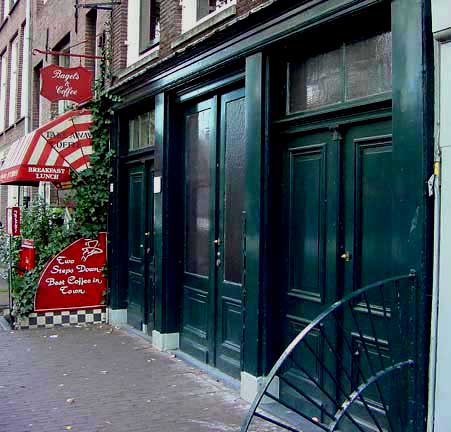
Front door of Prinsengracht
263 as it looked in September 2002
The building at number 263 Prinsengracht
in Amsterdam,
popularly known as the Anne Frank House, is not the place where
Anne was born, nor even the home where the Frank family lived
after Otto Frank moved from Frankfurt, Germany to the Netherlands
in 1933. Rather, it is a four-story merchant's house, built in
1635, where Anne's father, Otto Frank, operated two businesses:
one which produced pectin to be used in making jelly and other
products, and the other which produced herbs and spices for making
sausage.
In the photograph above, the double doors
with the frosted glass panels open into the warehouse on the
ground floor. Just inside the warehouse doors, there is a door
on the left which opens to the staircase up to the first floor.
The single door on the left opens directly to the staircase so
that customers didn't have to go through the warehouse to get
to the offices upstairs. In Europe, the floor directly above
the ground floor is always called the first floor. What Americans
call the first floor is always called the ground floor in Europe.
In my description of the house and annex, I will be using the
European terminology.
The building is a typical Amsterdam four-story
canal house which faces the Prinsengracht, one of Amsterdam's
most beautiful canals. Behind the house at 263 Prinsengracht
street is a separate building that was constructed at a later
time: a four-story annex with an attic. The annex is separated
from the main house by a space that is about 12 feet wide, but
it is connected to the main house by passageways.
The annex is the place where Anne and
her family hid for 25 months from the Nazis, along with the van
Pels family and Dr. Friedrich (Fritz) Pfeffer, a dentist who
was a friend of the Franks.
On the left in the photograph above,
there is an Italian restaurant which advertises on a sign in
English: "Two steps down, Best Coffee in Town." In
front of the Anne Frank House, but not shown in the photograph,
are some tables and benches where customers of the restaurant
can eat their take-out food.
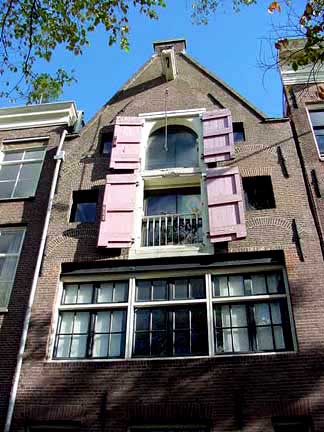 The house next door
to the left of the Anne Frank house
The house next door
to the left of the Anne Frank house
In her description of the canal houses
on either side of her father's business, Anne wrote in her diary
that the building to the right was the local branch of the Keg
company from Zaandam and the building on the left was a furniture
workshop.
 Sign on front of Anne
Frank house
Sign on front of Anne
Frank house
 Lock on glass door
at Prinsengracht 263
Lock on glass door
at Prinsengracht 263
In February 1942, the Nazis began rounding
up all the Jews in Germany and the occupied countries for evacuation
to the East in what the Nazis called "The Final Solution
to the Jewish Question."
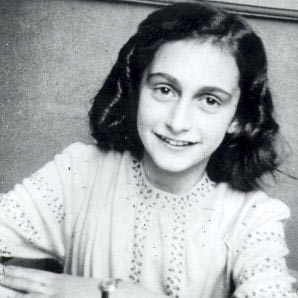 13-year-old Anne Frank
13-year-old Anne Frank
Knowing that his family would soon be
deported, Otto Frank began preparing a hiding place in the annex
with a two-year supply of food and other essentials. Five months
later, Anne and her family suddenly disappeared, leaving behind
notes saying that they had gone to Switzerland, which was a neutral
country during World War II. Otto Frank's brother actually did
escape from occupied France to Switzerland, but Otto Frank wanted
to remain in Amsterdam because he had a thriving business there.
Many other Jewish families in Amsterdam
also went into hiding, trusting that their Dutch neighbors and
business associates would not betray their hiding places to the
police. Approximately 25,000 Dutch Jews hid during the Nazi occupation
of the Netherlands which began after the Germans defeated the
Dutch in May 1940 in the early part of World War II.
Those unfortunate Dutch Jews who did
not go into hiding were sent to the transit camp at Westerbork,
from where they were then transported by train to Auschwitz,
the infamous killing center, located in what is now Poland, where
millions of Jews perished in the gas chambers. Many of the 160,000
Jews in the Netherlands were refugees, like the Franks and their
friends in the annex, who had escaped from Germany after Hitler
and the Nazis came to power in 1933. Westerbork was originally
a refugee camp for German Jews who were regarded as illegal immigrants
in the Netherlands after they escaped over the border from Nazi
Germany before the war.
The Franks went into hiding on July 6,
1942 shortly after Anne's 13th birthday on June 12th. One week
later they were joined by Hermann and Auguste van Pels, their
15-year-old son Peter and Peter's cat. Dr. Pfeffer joined them
on November 16, 1942, bringing along his dentist's drill.
On August 4th, 1944, the police raided
their hiding place in the annex and they were taken to the Westerbork
transit camp on a passenger train, after a short stay at the
Amsterdam headquarters of the Security Police. On September 3,
1944, all 8 were loaded onto a freight train and taken on the
last transport of Dutch Jews to Auschwitz, where they arrived
on the night of September 5th and 6th. Otto Frank was the only
one of the 8 who survived. He died on August 19, 1980 in Switzerland.
Hermann van Pels was murdered in the
gas chamber at Auschwitz in either September or October 1944,
according to the information presented at the Anne Frank House.
Anne's mother died of tuberculosis in January 1945 at Auschwitz.
Anne and her sister died of typhus at Bergen-Belsen; the others
all died from disease in various Nazi concentration camps to
which they were transferred from Auschwitz.
Anne and her sister, Margot, were sent
from Auschwitz on October 28, 1944 to the Bergen-Belsen exchange
camp on a transport which, according to the International Red
Cross, consisted of sick women who were expected to recover from
their illness. Later, Anne and Margot both became ill with typhus
and died in March 1945 during the horrendous epidemic in Bergen-Belsen.
Both were buried in one of the unmarked mass graves there.
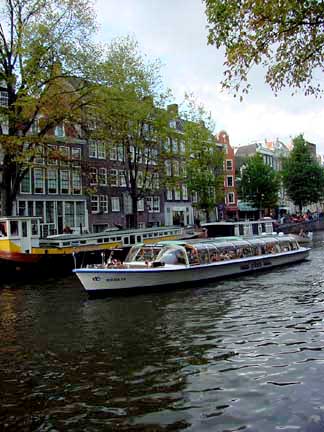
Canal boats on the
Prinsengracht go past the Anne Frank House
The photograph above was taken from the
street in front of the main house at 263 Prinsengracht. There
is no fence or barrier separating the street from the canal,
so I had to be careful not to step back too far to take a photo
of the house, for fear of falling into the water. A sign near
the house warns tourists to watch out for pickpockets who might
steal your purse or wallet. These signs are prevalent throughout
the city of Amsterdam.
Otto Frank's former factory and the annex
remained empty until the late 1950ies when a group of prominent
non-Jewish citizens of Amsterdam established the Anne Frank Foundation
for the purpose of preserving the building, which had been slated
for demolition. In 1957 the owners of the building donated it
to the Foundation. By that time Otto Frank had published Anne's
diary (in June 1947) and the name Anne Frank had become a household
word in America after a play based on her diary opened on Broadway
in 1955.
 The house at 265 Prinsengracht
is part of the Museum
The house at 265 Prinsengracht
is part of the Museum
In 1960, the house and the annex were
opened to the public as a museum. On September 28, 1999, the
house next door at 265 Prinsengracht was added to the museum
to provide more space for exhibits. The photo above shows house
#265, but there is no entry to the Museum from the outside door
of this building.
Beginning in 1995, a restoration project
was begun to put the front building back into its original condition
so that visitors today can see what it looked like when Otto
Frank operated his businesses there.
The annex where Anne and her family hid
from the Nazis is open to the public on every day of the year,
except on Yom Kippur, a Jewish holiday which falls on a different
date each year. Visiting hours are 9 a.m. to 9 p.m. between April
and August. From September to March, the house is open from 9
a.m. to 7 p.m. The entrance to the house is through a new modern
building at 267 Prinsengracht, two doors up the street. In this
building is a bookshop and a cafeteria that tourists can visit
at the end of their tour of the exhibits.
The Anne Frank house is located only
a few yards from the Westerkerk, a Protestant church with a clock
tower which Anne mentioned in the following entry in her diary:
Father, Mother and Margot still can't
get used to the chiming of the Westertoren clock, which tells
us the time every quarter of an hour. Not me, I liked it from
the start; it sounds so reassuring, especially at night.
The photograph below shows the famous
church tower. On the left is the modern building at 267 Prinsengracht;
the windows of the cafeteria on the first floor overlook the
church. The low building between the church and the cafeteria
is, believe or not, a bar. That's right, a bar adjoins the most
famous church in Amsterdam.
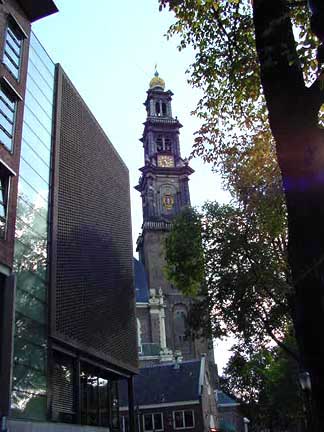 Windows of the cafeteria
on the left overlook Westerkerk tower
Windows of the cafeteria
on the left overlook Westerkerk tower
The photo below shows the other side
of the church where there is a booth for Pink Point of Presence,
an organization which provides information for gays and lesbians.
Amsterdam has a reputation for being the most tolerant and the
most diverse city in the world.
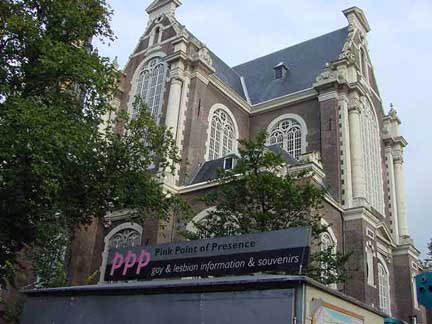
Gay and lesbian information
booth next to the Westerkerk
In front of the Westerkerk church is
the Homomonument by Karin Daan. This is a memorial to approximately
10,000 homosexuals who were sent to the Nazi concentration camps;
it consists of three triangles which define a larger triangle.
One triangle is raised up from the ground, as shown in the photo
below.
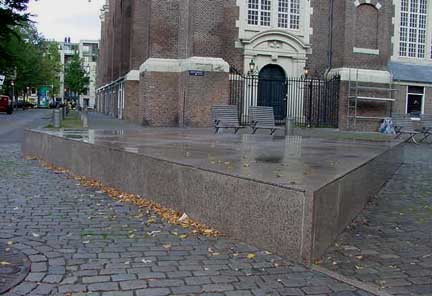 One of three pink marble
triangles in front of the Westerkerk
One of three pink marble
triangles in front of the Westerkerk
A second triangle is level with the ground,
as shown in the photo below. A third triangle is at a lower level
jutting out into the adjacent canal. Homosexual prisoners were
identified by a pink triangle which they had to wear on their
uniform; Communists and other political prisoners had to wear
a red triangle and German criminals in the concentration camps
were distinguished by a green triangle.
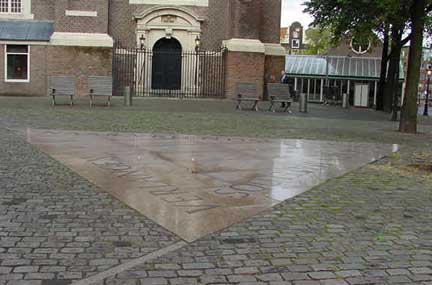
One of three pink marble
triangles in front of the Westerkerk
The words around the edge of the triangle
in the photo above are from a poem by Jacob Israel de Haan: "NAAR
VRIENDSCHAP ZULK EEN MATELOOS VERLANGEN." (Such a boundless
longing for friendship.)
Visitors to the Anne Frank house must
first purchase a ticket from the booth just inside the entrance
to 267 Prinsengracht, which is shown in the photograph below.
A free brochure about the exhibits inside is available at the
ticket booth. Signs warn that photography is not permitted in
the building, but cameras and backpacks do not have to be checked
at the door. There are no X-ray machines at the entrance and
purses and backpacks are not searched.
 Sign at the entrance
to the Anne Frank house at 267 Prinsengracht street
Sign at the entrance
to the Anne Frank house at 267 Prinsengracht street
The entry tickets are not timed and there
is no guide; visitors are allowed to stay as long as they like
and view the exhibits for as long as they wish. However, the
tour moves in only one direction and visitors may not go back
through the exhibit rooms. There are emergency exits throughout
the building which lead to stairs in the building at 265 Prinsengracht.
The exhibits are not wheel-chair accessible, and there is no
elevator in the Anne Frank house. Important visitors can obtain
permission to enter the Museum through the building at 265 Prinsengracht,
which has an elevator.
According to the brochure handed out
at the entrance:
Eight hundred school groups attend
one of the educational programs at the Anne Frank House each
year. There are changing exhibitions mounted focusing on current
issues. There is educational material compiled about Anne Frank
and World War Two, but also about right-wing extremism, prejudice,
discrimination, and ethnic and cultural diversity. The organization
tracks political extremism at home and abroad.
A small book entitled "A History
for Today, Anne Frank" which I purchased in the bookstore
at the Anne Frank House explains the mission of the Anne Frank
Foundation.
The following is a quote from the preface
of this book, written by Hans Westra, Director of the Anne Frank
House:
The goal of the Anne Frank House is
to keep alive the memory of Anne Frank and the period when National
Socialism was in power. This is not only a matter of human and
historical interest; it also has significance for us today. For
the Anne Frank House, the memory of Anne Frank is directly related
to a concern for preserving freedom and maintaining human rights
and a pluralistic and democratic society.
This page was last updated on March 16,
2009
|